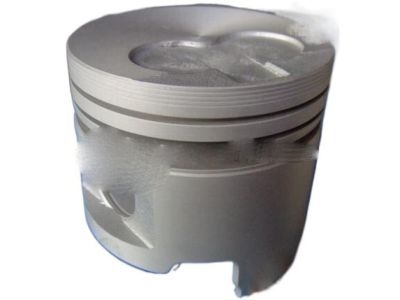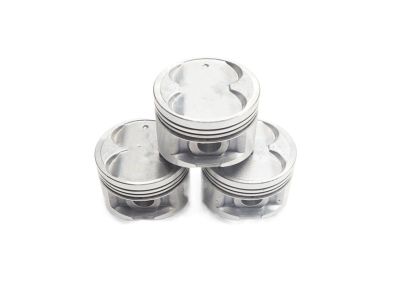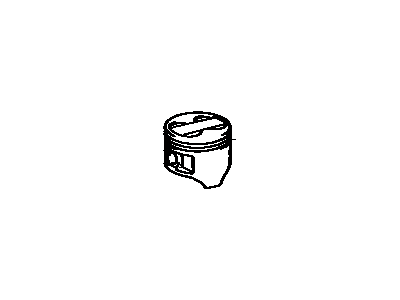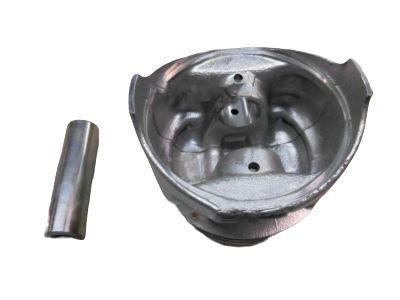

My Garage
My Account
Cart
Genuine 1986 Toyota MR2 Piston
Engine Pistons- Select Vehicle by Model
- Select Vehicle by VIN
Select Vehicle by Model
orMake
Model
Year
Select Vehicle by VIN
For the most accurate results, select vehicle by your VIN (Vehicle Identification Number).
2 Pistons found
- Product Specifications
- Other Name: Piston Sub-Assy, W/Pin
- Manufacturer Note: STD,STD
- Replaced by: 13101-16020-02
- Part Name Code: 13101
- Item Weight: 1.20 Pounds
- Item Dimensions: 4.0 x 3.7 x 3.5 inches
- Condition: New
- Fitment Type: Direct Replacement
- Require Quantity: 4
- SKU: 13101-16020
- Warranty: This genuine part is guaranteed by Toyota's factory warranty.
- Product Specifications
- Other Name: Piston Sub-Assy, W/Pin
- Manufacturer Note: O/S 0.50,O/S 0.50
- Part Name Code: 13101
- Item Weight: 1.30 Pounds
- Item Dimensions: 3.9 x 3.7 x 3.5 inches
- Condition: New
- Fitment Type: Direct Replacement
- Require Quantity: 4
- SKU: 13103-16020
- Warranty: This genuine part is guaranteed by Toyota's factory warranty.
1986 Toyota MR2 Piston
With ToyotaPartsDeal.com, you have access to an extensive inventory of genuine 1986 Toyota MR2 Piston, all priced competitively. Feel secure in your purchase, as all our OEM 1986 Toyota MR2 Piston are covered by the manufacturer's warranty. Plus, we offer a hassle-free return policy and speedy delivery service.
1986 Toyota MR2 Piston Parts Questions & Experts Answers
- Q: How to properly install piston/connecting rod assemblies for the 1986 Toyota MR2?A: Before installing the piston and connecting rod assemblies, ensure the cylinder walls are clean, the top edge of each cylinder is chamfered, and the crankshaft is in place. Remove the connecting rod cap from the number one connecting rod, take out the old bearing inserts, and wipe the bearing surfaces with a clean, lint-free cloth. Clean the back side of the new upper bearing half and lay it in place in the connecting rod, ensuring the tab fits into the recess without hammering or nicking the bearing face, and do not lubricate it. Clean the back side of the new lower bearing insert and install it in the rod cap, again ensuring the tab fits into the recess without applying lubricant. Position the piston ring gaps at 90-degree intervals around the piston and slip a section of plastic or rubber hose over each connecting rod cap bolt. Lubricate the piston and rings with clean engine oil, attach a ring compressor to the piston, and leave the skirt protruding about 1/4-inch to guide the piston into the cylinder while compressing the rings until they are flush with the piston. Rotate the crankshaft until the number one connecting rod journal is at bottom dead center and apply engine oil to the cylinder walls. With the notch on top of the piston facing the front of the engine, gently insert the piston/connecting rod assembly into the number one cylinder bore, resting the bottom edge of the ring compressor on the engine block, and tap the top edge of the ring compressor to ensure contact around its circumference. Carefully tap the top of the piston with a wooden, rubber, or plastic hammer handle while guiding the connecting rod into place on the crankshaft journal, maintaining downward pressure on the ring compressor to prevent the piston rings from popping out. If resistance is felt, stop immediately to identify and resolve the issue without forcing the piston. After installation, check the connecting rod bearing oil clearance before permanently bolting the rod cap in place by laying a piece of Plastigage on the number one connecting rod journal, ensuring it does not cross the oil hole. Clean the connecting rod cap bearing face, remove the protective hoses from the connecting rod bolts, and install the rod cap, ensuring the mating marks align. Tighten the nuts to the specified torque in three steps without rotating the crankshaft. Remove the rod cap carefully to avoid disturbing the Plastigage and compare the width of the crushed Plastigage to the scale on the container to determine the oil clearance, ensuring it meets specifications. If the clearance is incorrect, check for dirt or oil between the bearing inserts and the connecting rod or cap, and recheck the journal diameter. Carefully scrape off any Plastigage material without scratching the bearing, then apply a uniform layer of clean moly-based grease or engine assembly lube to both bearing faces. Push the piston into the cylinder to expose the bearing insert face, slip the protective hoses over the rod bolts, slide the connecting rod back into place on the journal, remove the protective hoses, install the rod cap, and tighten the nuts to the specified torque in three steps. Repeat the procedure for the remaining piston/connecting rod assemblies, keeping the bearing inserts and connecting rod and cap clean, ensuring the correct piston is used for each cylinder with the notch facing the front of the engine. After all assemblies are installed, rotate the crankshaft by hand to check for binding, and finally, check the connecting rod end play against specifications to ensure it is correct, addressing any issues with resizing at an automotive machine shop if necessary.










